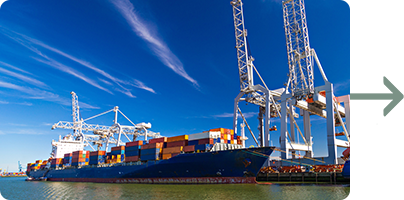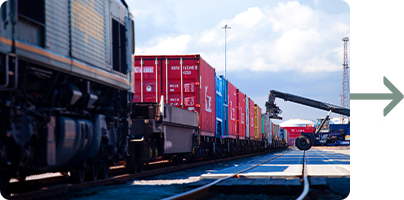Unique Logistics Solutions to Complex Container Drayage Issues
Today, more than 80% of global shipping involves containers. They're packed with everything from personal storage items in dry containers to heavy machinery on flat rack containers. For business owners shipping products, getting a container from point A to point B requires precise planning and high-level tracking. But that's easier said than done when global supply chains become over-congested, leading to loading time issues and delays.
That's bad news for business owners who are already under a massive amount of stress. The truth is that container storage delays can cripple a business, but there's a viable solution: drayage brokers in San Diego, CA like RelyEx. Drayage companies provide unique solutions to minimize demurrage and help ensure the successful delivery of your freight.
With more than 30 combined years of experience and a solutions-oriented team, RelyEx has quickly become the first choice for streamlined, efficient drayage services. To understand the true value of RelyEx's offerings in the global logistics industry, it helps to understand first what drayage is and why it's used.
What is Drayage and Why Is It Important?
If you're a seasoned business owner who uses port drayage to transport your products, you know exactly how important the service can be. But if you were to poll a group of random people, you may get five different definitions of the term "drayage." That begs the question, how is one of the most crucial steps in the supply chain and most vital components of global trade such a confusing concept? When you break it down, it's not too difficult to grasp.
Drayage, by definition, means the transportation of freight from an ocean port to another destination. Today, drayage is also used to describe the process of transporting products and goods over short distances or over "the first mile."
While drayage often means short-distance movements during the supply chain process, it's primarily used in the container shipping space. Drayage loads usually have arrival and departure points in the same city and don't include long-haul, national transportation.
Let us know how we can help.
drayage broker Services
Service Areas
Because a drayage load can mean a few different things, confusion among carriers is common. Many carriers link drayage with going into a port, but that isn't always true. While all drayage loads typically originate from a port of entry, there are often several legs of a drayage journey before a container turns up at its final stop. Legs of a drayage load may include:
Why Are Drayage Companies in San Diego, CA So Important?
You may be thinking, what's so important about drayage? It's such a small step in the container storage transport process. In reality, it's an integral piece needed in the logistics industry and a crucial part of U.S. supply chain management.
To truly understand the importance of drayage, let's use flowers as an example. Most cut flower shipments enter the market from areas in South America until they end up at Dutch auction houses. Once there, wholesalers purchase flowers in bulk and send those products to retail outlets worldwide. Because flowers are perishable, they typically need to be refrigerated and are often shipped in reefer containers. These refrigerated vessels must maintain a certain temp to prevent loss.
Drayage companies like RelyEx allow flower shippers to send their products from Argentinian ports to airports in the Netherlands with peace of mind because their products are protected. The only way to accomplish this feat is with the help of swift, meticulous port drayage services. Drayage companies allow flower shippers to send their products from Argentinian ports to airports in the Netherlands with peace of mind, because their products are protected. The only way to accomplish this feat is with the help of swift, meticulous port drayage services.
If port drayage is compromised, it can cause delays and even fines. You know the packages you get delivered to your front door from apps like Amazon? Without drayage and drayage brokers, one or two-day shipping times wouldn't even be possible.
As a multi-billion-dollar industry in the U.S. alone, it seems like drayage shipping issues shouldn't exist. But the fact is inefficiencies and congestion are still major problems at ports. Whether it's a lack of carriers, absent chassis, or overburdened terminals, delays lead to missed deadlines, lost revenue, and worse.
But anytime challenges exist, so too do innovative solutions.
QUOTE REQUEST
Port

Yard

Warehouse

Rail

The RelyEx Difference
RelyEx was created because our founders saw a need in the logistics space for more reliability and efficiency. The reality of the shipping and logistics industry is that it has become very transactional. It's an odd evolution, because most businesses seek a third-party logistics partner that is accessible, transparent, and committed to providing solutions.
As the logistics space continues to grow, it creates newfound expenses and complexities. Clients like ours know that and need a supply chain partner who is genuinely interested in their business. By understanding the needs of our customers and carriers, we can provide the most reliable, effective drayage services possible.
Unlike some drayage companies in San Diego, CA, we begin managing your containers before they ever hit the ports by mapping out the most efficient pathways of delivery. That way, our team can discover the best drayage pathways to expedite delivery time and reduce fees that cut into profits.
Our valued drayage customers choose RelyEx because:

RelyEx Solves Problems
At RelyEx, we like to consider ourselves problem solvers. The nature of the container drayage industry presents new challenges every day, but we're firm believers that there's a solution to every hurdle we encounter. And while some drayage businesses implement a reactive approach, RelyEx customers choose us for our proactive mindset. We take pride in solving your company's drayage challenges to help you avoid frustrating fees, missed expectations, and delayed shipments. We strive to make every transaction successful and streamlined by partnering with shippers who prioritize transparent, prompt, and accurate communication.

RelyEx Has a Unique Vantage Point
RelyEx approaches your business from the customer's perspective - a unique approach that helps us provide high-quality, effective drayage services. We've been in the customers' shoes, know their pain points, and because of that, provide first-hand solutions to stressful supply chain issues. With over 30 years of collective knowledge, our team excels in:
- Inventory Management
- Logistics
- Purchasing
- Finance
Our varied, high-level drayage shipping experience helps us achieve our overarching goal: expertly managing your freight movement needs. That way, you can direct your time and focus on growing the core aspects of your business while we handle the heavy lifting. Throw in proactive planning to avoid bottleneck situations and strong communication for transparent customer relations, and you can see why so many companies trust RelyEx.

RelyEx Nurtures Strong Carrier Relationships
When it comes to shipping logistics, it only takes one mistake by a mediocre worker to disrupt your business. That's why, at RelyEx, we pride ourselves on forming and nurturing relationships with carriers who match our standards of care. Our founding partner started his career transporting freight for companies as an on-demand carrier. He uses that knowledge to maximize the resources of our carriers so that our customer's expectations aren't just met - they're exceeded.
Why Choose RelyEx as Your
Drayage Company in San Diego, CA?
Based in the port city of San Diego, RelyEx has a keen understanding of the challenges of managing the inbound and outbound flow of containers. Our team of container drayage experts provides your business with unique solutions to nuanced shipping problems, minimizing demurrage and ensuring the successful delivery of your freight.

Customers choose RelyEx because:
- We are a reliable drayage logistics partner that manages your freight from beginning to end
- We have a rare industry vantage point with 30+ years of client-side experience
- We foster and fortify the strongest vendor relations
- We take a proactive approach to problem-solving, not a reactive approach
Let us know how we can help.
 843-885-3082
843-885-3082

Your Drayage Shipments Managed from Start to Finish
Some drayage brokers don't care how customers feel about their service as long as they sign a contract and get paid. As a solutions-oriented team, RelyEx takes the opposite approach. We're motivated by the opportunity to overachieve for our customers and to provide them with the best logistics experience possible. With professional experience as carriers and shippers ourselves, we know the roadblocks and challenges you're facing. We excel at mapping out the best plans of action to solve those problems. But that's just the start.
Our tracking experts monitor and manage every aspect of your drayage shipment from booking to delivery, 24/7. Once booked, we look for the availability of your containers hourly once they're at port. When they arrive, our team acts quickly to access your storage containers when they're available.
Plus, RelyEx ensures your company's requirements are met by the carrier during loading and delivery and provide necessary documentation as fast as possible. With real-time tracking updates and access to our customer service professionals, your team has complete visibility throughout the shipping process.
We Source Top-Notch Operators at the Best Prices
Over the years, RelyEx has built a strong network of drayage carriers, transloading locations, and container storage spaces to provide you with the best possible options to match your drayage service needs. We know that searching for quality service presents an added layer of complexity and stress to our customers. That's why we work hard to take that off your plate by connecting you with our reliable shipping partners.
With a background moving freight as an on-demand carrier, our founding partner understands how to maximize the resources and equipment of our carriers to match your needs.


We Make Transparent, Timely Communication a Priority
Like other industries, the global logistics space is complex. Mistakes will be made, and problems will happen. With those truths in mind, RelyEx has built its reputation as problem solvers. Unlike other drayage companies, we don't shy away from this industry's complexities because we take pride in solving problems. Even better, we aim to do what's needed to avoid those problems altogether.
As your logistics partner, we will provide your company with accurate, transparent, and prompt communication. If there are unexpected issues, we'll notify you immediately and will provide several options to remedy the problem. We even offer custom reporting for large clients who need at-the-moment updates and quick access to shipment documentation.
We Have Robust Project Management Experience
Why let the unpredictability of your industry dictate your success? With a background working in manufacturing, our founders are familiar with the demands of managing production schedules and sales orders. That experience makes it abundantly clear to us that every business and industry is different. If you struggle with seasonal surges or other factors, our team supports your business with a mapped-out plan and schedule, so you stay ahead of the game.
QUOTE REQUEST
How to Avoid
Demurrage Fees for Your Business
Based in the port city of San Diego, RelyEx has a keen understanding of the challenges of managing the inbound and outbound flow of containers. Our team of container drayage experts provides your business with unique solutions to nuanced shipping problems, minimizing demurrage and ensuring the successful delivery of your freight.
What is shipping demurrage?
Demurrage is a charge issued by a port, carrier, or railroad company for storing containers that do not load and unload their cargo promptly. Once the daily limit of free time is exceeded, shippers are charged daily demurrage fees until their cargo is shipped. Though different ports have different policies, charges can range from $75 to $150 per container, per day, for a set number of days. Additional demurrage fees are incurred if a shipper exceeds the port's parameters.

What causes demurrage charges?
Even when shippers maintain a tight schedule for unloading freight, external factors can play an uncontrollable part. Typically, shipping mistakes caused by human error trigger the most demurrage charges. Some of the most common causes of demurrage include:
- Paperwork Errors
- Payment Delays
- Documents Received Too Late

Paperwork Errors
Typically, shippers need four specific documents to clear shipments through customs: A Bill of Lading (or BOL), a commercial invoice, a packing list, and an arrival notice. Seasoned drayage brokers like RelyEx are used to preparing these documents, but new shippers tend to miss this step due to inexperience.
Payment Delays
If a shipper only pays for part of their shipment, a vessel operator may refuse to release their freight until their bill is fully paid. Payment delays lead to cargo detention at the port of entry, which triggers demurrage charges.
QUOTE REQUESTDocuments Received Too Late
Paperwork is needed when you're shipping goods with a drayage company. When documents like the Certificate of Origin or Bill of Lading arrive at their destination late, you can expect demurrage fees. RelyEx avoids this situation entirely by being proactive when submitting paperwork.
Additional causes for demurrage fees can include:
- Damaged Container Storage
- Custom Released Containers
- Storage Containers Are Too Heavy
Free Consultation
RelyEx:
The Supply Chain Partner You Can Count On
At RelyEx, we know first-hand how stressful supply chain problems can be for business owners. Though drayage shipping might seem minor on the surface, it affects every stage of your shipping process. And when inevitable hurdles manifest, RelyEx propels you over the proverbial roadblocks with a proactive mindset and a passion for challenging projects. We believe that all problems have a solution, and our unique vantage point allows us to provide first-hand solutions to customers in a wide array of industries.
When it comes to your business, don't settle for anything less than RelyEx. Contact our office today to learn more about how we make your shipping experience streamlined and stress-free.
 843-885-3082
843-885-3082
Latest News in San Diego, CA
Photos: 10 seniors dogs available for adoption and fostering in San Diego
Amber Coakleyhttps://fox5sandiego.com/news/local-news/photos-10-seniors-dogs-available-for-adoption-and-fostering-in-san-diego/
SAN DIEGO (FOX 5/KUSI) — The San Diego Humane Society is asking for the community’s help as animal shelters across the county are becoming overwhelmed.Officials with the organization said Wednesday that their facilities are maxed out by a record number of dogs in care, something they referred to as “a state of emergency.”As the summer months inch closer, the Humane ...
SAN DIEGO (FOX 5/KUSI) — The San Diego Humane Society is asking for the community’s help as animal shelters across the county are becoming overwhelmed.
Officials with the organization said Wednesday that their facilities are maxed out by a record number of dogs in care, something they referred to as “a state of emergency.”
As the summer months inch closer, the Humane Society warned that numbers are expected to triple. In an effort to get ahead of the influx, the organization is encouraging adoption and fostering for the many K9s who have no place to call home outside the shelter doors.
Here’s a closer look at eight senior dogs that are available for fostering and adoption in the region:
Theodopolis: 9-year-old male Siberian Husky mix
“Theo is a lover of simple pleasures. He finds joy in the rhythm of his paws hitting the pavement on a leisurely walk, and the warmth of the sun on his fur during his afternoon naps,” said the Humane Society.
Blue: 8-year-old Pit Bull Terrier mix
“Because of her initial fearfulness with new people, we are recommending she go to a home without small kids (under 10). Her prior owner describes her as a well housebroken pet who is ‘lazy and sweet.’ She loves car rides and leash walks,” the Humane Society explained.
Mocha: 10-year-old Pit Bull Terrier mix
“Mocha carries a calm and mellow disposition, making her an excellent companion for those seeking a peaceful and friendly pet,” said the Humane Society. “She loves the simple pleasures of life, like being petted, which she receives with a gentle wag of her tail.”
Nikki: 9-year-old American Pit Bull Terrier
“Nikki has a tail in almost constant wagging motion…maybe she is directing an orchestra? We like to think so! Nikki wants to be the queen of her own castle, so her new home will have to be free of other canine companions,” explained the Humane Society. She prefers to have your love all to herself!
Maya: 7-year-old Siberian Husky Mix
“Maya is a sweet girl who does great on walks and loves to make human friends wherever she goes. She prefers to keep her toys and food to herself, so she may do best as the only dog in the home. Huskies are an extremely vocal and high energy breed that do best when the world is at their paws,” said the Human Society.
Tyler: Labrador Retriever mix with unknown age
“Tyler is a bashful boy who will need to find a home that is committed to helping him build his confidence. Tyler’s next human should have experience with positive reinforcement training, a calm and quiet house with a securely enclosed yard, and unlimited amounts of patience and understanding,” said the Humane Society.
Timon: 12-year-old Chihuahua mix
“Despite his age, Timon is full of love and ready to share his affection with a patient family who will cherish him in return. Although not much is known about his past, he has quickly become a favorite among the staff,” said the Humane Society.
Princess: 8-year-old Shar Pei mix
“She’s a special soul who prefers a peaceful environment and the company of adults. While shy initially, and she needs some time to get comfortable with new faces. She prefers gentle handling and isn’t a fan of being restrained. She’s an independent spirit, with a personality that truly blooms once she trusts you,” the Humane Society described.
Roxi: 10-year-old American Staffordshire Terrier mix
“She is a sweet girl, looking for her new best friend! Roxi enjoys car rides, long walks on beautiful sunny days, and cuddles! She is a mellow girl, who will do best as the only pet- as she prefers not to share her things,” said the Humane Society.
“Luna came in as a stray and it’s been a joy getting to know her better! This mellow and friendly girl adores leisurely strolls around the block, and she enjoys taking things slow and sniffing the world around her. Luna’s fondness for attention shines through as she happily accepts being pet and brushed and will look up at you with sweet eyes,” described the Humane Society.
More information about adopting and fostering dogs, cats, and other shelter animals can be found here.
Ashcraft stingy, but run support proves scarce
MLB.comhttps://www.mlb.com/news/graham-ashcraft-sharp-in-no-decision-vs-padres
SAN DIEGO -- A perusal of the Reds’ lineup doesn't show many heavy hitters. From the fifth through ninth spots, every batter owns a batting average below .200.A scan of the bench lacks immediate solutions. Tyler Stephenson and Christian Encarnacion-Strand missed the past four games since each was hit by a pitch. Jake Fraley, who is still regaining his strength from being sick, missed the past two.Put it all together, and there wasn't much support for ...
SAN DIEGO -- A perusal of the Reds’ lineup doesn't show many heavy hitters. From the fifth through ninth spots, every batter owns a batting average below .200.
A scan of the bench lacks immediate solutions. Tyler Stephenson and Christian Encarnacion-Strand missed the past four games since each was hit by a pitch. Jake Fraley, who is still regaining his strength from being sick, missed the past two.
Put it all together, and there wasn't much support for Graham Ashcraft on Wednesday afternoon. Ashcraft worked six strong innings but took a no-decision in the Reds’ 6-2 loss to the Padres in the series finale at Petco Park.
“He put us in a situation where one big at-bat, one big hit could make all the difference," Reds manager David Bell said of Ashcraft. "Today, the Padres put together a nice inning and got the big hit against a guy that’s been great for us.”
Jake Cronenworth's grand slam in the bottom of the seventh inning against reliever Fernando Cruz snapped a 2-2 game. Cincinnati dropped two of three in the series and finished 2-4 on the road trip through Texas and San Diego.
The Reds score runs in bunches when they win but rarely get over the hump in low-scoring games. While they have won 14 of 16 games when scoring five or more runs, they've lost 13 of 15 when scoring four runs or fewer.
During the road trip, the Reds’ rotation posted a 2.21 ERA. Their lineup batted just .201 with 60 strikeouts.
Not only is the lineup missing three starters of late, it has been without TJ Friedl and Matt McLain since Opening Day because of injuries. Noelvi Marte is serving an 80-game suspension for PED use.
Illnesses roughed up the clubhouse in mid-April, yet the Reds still have a 16-15 record.
“We’re keeping everything in perspective," said center fielder Stuart Fairchild, who was 0-for-3 but robbed Manny Machado of a three-run homer with a spectacular catch. "I think actually we’re doing a really good job of competing and making do with what we’re working with.
“I don’t think anyone is hanging their head on it. It's been tough with the sicknesses and the injuries we’ve been dealt. We’re taking it in stride.”
Ashcraft, who gave up two unearned runs and five hits against the Padres, allowed one earned run over 6 1/3 innings on Friday at Texas. Cincinnati wound up losing that game also, 2-1.
On Wednesday, Jackson Merrill grounded to the right side in the fourth inning with one out. Second baseman Jonathan India made a glove flip to first base, but Jeimer Candelario dropped the ball for an error. Later, with two on and two out, Jurickson Profar's two-run single pushed across the pair of unearned runs.
In the top of the seventh inning against lefty reliever Yuki Matsui, the Reds' struggling bottom of the order had a chance to put something together. India led off with a walk, and Santiago Espinal drew a one-out walk.
Matsui struck out Candelario, and Enyel De Los Santos struck out Luke Maile to escape the jam. That might have normally been a situation where Bell could have used pinch-hitters for an offensive boost.
“It would have had to have been a real obvious situation. These guys have been dealing with quite a bit of pain," Bell said of Encarnacion-Strand and Stephenson. "Thankfully, there’s not anything that’s going to keep them out long term.
“I fully expect Christian and Tyler to either be back in the lineup Friday or 100% available. I wouldn’t say we were all the way out of the woods today, but given the perfect situation, they would have been available.”
There are glimmers of offensive hope. Candelario went 5-for-11 in the series after an 0-for-19 slump. India went 9-for-22 on the road trip. Friedl is expected to begin a rehab assignment on Thursday and could be back within a couple of weeks.
If the Reds rotation, which has a 3.78 ERA for the season, keeps that up, things should improve.
“There’s a lot of stuff that we’re building off of right now," Ashcraft said. "We’re having guys go deep in the ballgames. We’re saving the bullpen from having to cover four or five innings. If we continue doing that, it’s going to put us in a great spot.”
Did you like this story?
In this story:
Mark Sheldon has covered the Reds for MLB.com since 2006, and previously covered the Twins from 2001-05. Follow him on Facebook.
Relocation of historic homes makes way for a new park in downtown San Diego
Christina Bravohttps://www.nbcsandiego.com/news/local/historic-homes-relocated-downtown-san-diegos-new-giant-park-east-village-green/3501602/
If it seems like you've read more than a few news stories lately about fresh parks coming to San Diego, you wouldn't be mistaken.Just last week, Port of San Diego officials broke ground on a $65 million open space that will wrap around the USS Midway Museum along the Embarcadero. Freedom Park will stretch 10 acres from the west end of Navy Pier to the Bob Hope Memorial when it's completed in 2028....
If it seems like you've read more than a few news stories lately about fresh parks coming to San Diego, you wouldn't be mistaken.
Just last week, Port of San Diego officials broke ground on a $65 million open space that will wrap around the USS Midway Museum along the Embarcadero. Freedom Park will stretch 10 acres from the west end of Navy Pier to the Bob Hope Memorial when it's completed in 2028.
Also, the park formerly known as Petco Park's Park in the Park (that's a lot of park) recently got a $20 million overhaul and reopened just in time for the 2024 San Diego Padres season with added amenities for the public. Then there's the newly minted Children's Park on Island Avenue, coming in at $9 million.
The most recent and most expensive city-owned development is underway in East Village, though, where San Diego leaders have budgeted $80 million to transform a four-acre lot into a sprawling recreation area for literally the whole family. Kids can climb the jungle gym or frolic in the splash pad, dogs can run at the off-leash park, and adults can lounge on the central lawn. When the first phase of the project opens in mid- to late 2025, there will also be game tables, public art, a stage for outdoor entertainment, a two-story community center and a pricey underground paid parking garage.
All these parks are part of the city's vision to make an interconnected greenway throughout San Diego with a focus on developing active play spaces downtown, according to San Diego's Urban Division Deputy Director, Brian Schoenfisch.
"It's part of the type of infrastructure that we are focused on investing in here in downtown San Diego, which is really focused on bringing people out, getting people out of their cars ... [and] include amenities that will attract families and attract people downtown, Schoenfisch said. "There's really this focus on creative, active play space all throughout downtown right now."
While there is no official master plan yet in place to create this interconnected park plan, the Uban Division has built a collection of concepts to envision this "green paradise." They say the idea originates from San Diego's first city planner John Nolen's vision for a city with greenways connecting Balboa Park to the San Diego Bay. While that plan never came to fruition in the way Nolen envisioned, the city of San Diego is working toward the concept 120 years later.
"Really the anchor of that is East Village Green," Schoenfisch said.
East Village Green started construction in August of this year, but the project caught some recent attention online when two historic homes that were situated along G and 14th Streets were moved from their long-lived location on April 13.
"Even the houses can't afford the rent in San Diego," one Redditer commented.
But the eviction wasn't as harsh as it appeared: The late-1800 and early 1900 homes known by historians as The Murray Apartments and the Daggett Family Residence were moved for the second time in their lifetimes — this journey was just around the block to their new permanent locations along F Street. They are now staged next to another retro-looking home that is privately owned.
Working to ensure the two Victorian-style homes were protected during their move and restored to a condition as historically accurate as possible is architect and consultant David Marshall, president of Heritage Architecture and Planning. He and his team have quite a bit of experience with historic remodels, most recently working with the Hotel Del Coronado to ensure its $160 million renovation preserved the iconic red-topped buildings in its original Victorian style.
The East Village Green project was pretty moderate in comparison. It took just a few hours and "went [off] without a hitch," Marshall said.
"They put them on wheeled dollies with hydraulic lifts on them, and then they pull them with the truck," Marshall said, "and they basically took them around the corner in order to get them to their site. "They were taken east on G Street and then north on 15th Street around to their new foundations."
Photos: East Village Park Approved with $80M Price Tag, 16 Years After Original Design
The homes were privately owned before the city acquired them and weren't in the best condition. Marshall said they found termites, dry rot and several renovations that weren't accurate to their time period. The architects have already treated the houses with fresh coats of paint in their original color schemes, which were found buried under several layers of paint. The city is paying to restore the interior of the homes as well and plans to open them to the public in the future, although their use won't be determined until another round of public input and, more importantly, funding approval.
As for why they needed to be moved, the two homes were sitting in a prime location for the project’s dog park, which was one of the community's major asks during the planning process for East Village Green, according to Schoenfisch. The homes were also previously adjacent to 14th Street, which will now be a pedestrian promenade that can be closed off with bollards for a farmers' market or other community events.
"It's going to be a great venue for the community to have events, whether it's closing off 14th Street or using the new stage that will be at the center of the park," Schoenfisch said. "It certainly is something that this community has long desired."
The project has been in the making for nearly two decades and was first presented as part of the updated downtown community plan in 2006. A proposal was finally approved by the San Diego City Council in December 2019 and got the green light in 2022 to move into the next phase after securing additional funding, which would allow for the 185-space parking garage but eliminate some proposed cafes and a shade structure.
"It took a long time to figure out how to best treat these buildings, how the park would be located and arranged," Marshall said. "The city had to purchase various properties in order to create this downtown urban park. And it was a big challenge. It's a long-term project and we're in the final home stretch."
Humphreys Concerts by the Bay 2024 lineup
Kate Murphyhttps://www.axios.com/local/san-diego/2024/05/01/humphreys-concerts-by-the-bay-2024-season
Humphreys Concerts by the Bay is bringing big shows to San Diego this summer with a mix of longtime favorites and new artists t...
Humphreys Concerts by the Bay is bringing big shows to San Diego this summer with a mix of longtime favorites and new artists to entice a fresh generation of Humphreys loyalists.
Why it matters: The seasonal outdoor venue on Shelter Island is a local landmark for live music and entertainment, hosting country music legends, pop stars, reggae bands, R&B musicians and comedians since 1982.
State of play: Humphreys' 42nd season opened this month with sold-out shows for Faye Webster and Maoli, plus headliners Brittany Howard, Elle King and DannyLux. Rising stars, beloved mainstays and veteran musicians are scheduled through Nov. 16, with several others making their venue debuts:
Following the opening stint of newcomers, Alan Parsons kicks off a string of concerts by popular returning performers this month.
If you go: The 1,400-seat venue is between Humphreys Restaurant and Humphreys Half Moon Inn, which offer dinner-and-room packages.
The intrigue: Use the Shelter Island boat ramp to kayak, boat or paddleboard out onto the bay to hear shows from the water.
What's next: Check out the full schedule here.
San Diego hospitality, service workers rally for $25 minimum wage
Kelvin Henryhttps://www.nbcsandiego.com/news/local/san-diego-hospitality-service-workers-minimum-wage/3504212/
Local labor union leaders marched through downtown on Wednesday, calling on San Diego's elected leaders to pass an ordinance mandating a $25 minimum wage for service workers in the city.“This ordinance will lift the bar to $25 an hour for folks that work in the major hotels in the city of San Diego, and to name some of the venues that it would encompass, it would be the Convention Center, the Civic Theatre and Petco Park,” Fernanda Flores, IATSE Local 122 political director, said.The journey during the march took th...
Local labor union leaders marched through downtown on Wednesday, calling on San Diego's elected leaders to pass an ordinance mandating a $25 minimum wage for service workers in the city.
“This ordinance will lift the bar to $25 an hour for folks that work in the major hotels in the city of San Diego, and to name some of the venues that it would encompass, it would be the Convention Center, the Civic Theatre and Petco Park,” Fernanda Flores, IATSE Local 122 political director, said.
The journey during the march took the workers on a route from near the Bayfront to city hall. The goal is to highlight their call to action surrounding a wage increase, according to the workers involved in the march.
“A lot of our workers are not able to make ends meet, and we have seen a huge trend in the last year just to be able to make it here in San Diego. A lot of the employees have had to go across the border to live,” Flores said.
One of the workers at the march said it would bring peace of mind to many workers that are struggling to make ends meet.
“It’s going to make it easier for everyone to live. I’ll be able to pay off some debt finally, maybe actually put some towards my house. I have a child that’s starting at SDSU this fall, and it’ll be a good way to not actually have to worry about paying that tuition,” Jordan Sullivan, a local audio-visual worker, said.
The rising cost of living in the San Diego area will mean more people will need to see wages rise to keep up with costs, according to local economists.
“The cost of living in San Diego is really high, particularly in terms of housing, and so people working in those industries are typically at the lower end of the economic spectrum, so this should give them a boost to give them more money to spend and help them, in terms of dealing with issues like high rent and other things,” Alan Gin, University of San Diego economics professor, said.
Gin says there are mixed research about the impacts rising wages would have on the labor market.
“Usually, when an increase in the minimum wage is talked about, there is some concern talked about on the impact on employment. The research in economics is mixed on that. There’s no clear evidence that an increase in the minimum wage then will lead to significant decrease in employment,” Gin said.
Recently, fast food workers in California received a pay raise to $20 per hour. Healthcare workers are expected to receive an hourly pay raise over time as well.
Higher wages lead to a more stable labor market, Gin says.
“One thing that it does do is you have a more stable workforce, in the sense that if people are making a pretty good income, there’s less turnover, so businesses will save on costs that way, in terms of not having to retrain new workers,” Gin said.
Union leaders are pushing for an ordinance to be introduced, passed and in effect by early 2025.
Disclaimer:


